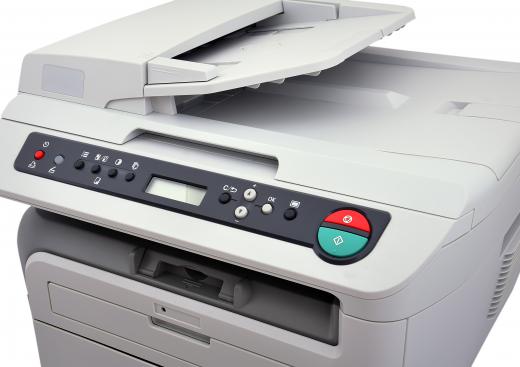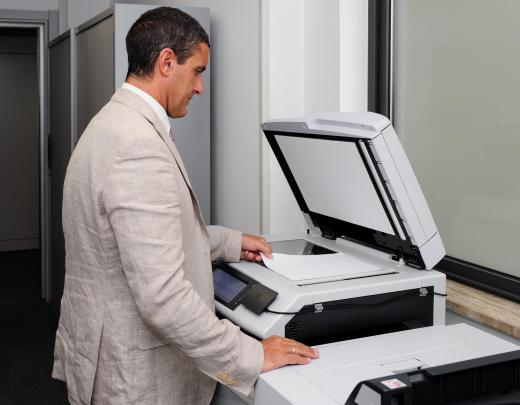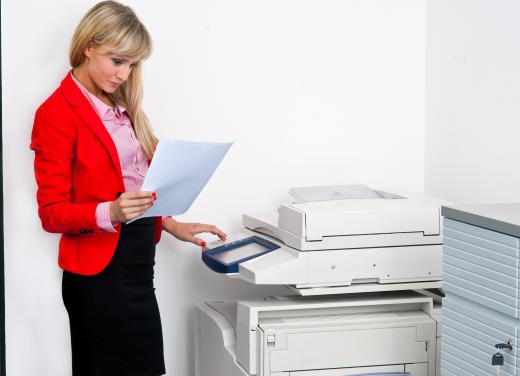How does a Xerox® Copier Work?
 Michael Pollick
Michael Pollick
A Xerox® copier, generically known as a photocopier, essentially works on the principles of static electricity. Electrical charges can be either positive or negative, which is somewhat similar to the poles of magnets. The negative end of a magnet will stick instantly to the positive end of another magnet, but two negatives or positives will repel each other. The same thing happens with negative and positive electrical charges; a negatively charged comb will attract positively charges flakes of pepper or grains of salt.
What a Xerox® copier does is take advantage of this natural electrical attraction or repulsion. What we see as a document to be copied is actually viewed as nothing more than black or white spaces to a Xerox® copier. When the document is placed on the glass tray for copying, a number of processes happen all at once. This is where the science of photocopying begins.

Beneath the transparent glass tray lies a flat belt or round drum called a photoreceptor. The surface of this photoreceptor is made from special materials which can be negatively and positively charged in different areas at the same time. An electrical element known as a Corona wire moves across the photoreceptor and gives the entire surface a positive electrical charge, much like rubbing a latex balloon or running a comb through hair. Once the entire surface of the photoreceptor is positively charged, an intensely bright light moves across the surface of the original document to be copied.

This light emits photons which can easily penetrate the white sections of the document, but not the dark areas we see as lettering. When the photons strike the photoreceptor's surface, those areas become electrically neutralized. The areas of the photoreceptor under the dark areas of the document, however, still remain positively charged. Essentially, a Xerox® copier "paints" the photoreceptor drum or belt with static electricity, creating a patch of positively charged images of letters surrounded by negatively charged areas that will remain white.

Once the image of the document has been statically "painted" on the drum or belt, the Xerox® copying system covers the plate with a negatively-charged black powder called toner. Wherever the toner particles find positively-charged areas on the photoreceptor, they will stick like the pepper flakes on a statically-charged comb. The toner will not stick to the negatively-charged areas of the belt or drum, so those areas will remain white.

After the toner particles have settled into the positively-charged areas, a second sheet of paper is introduced above the photoreceptor. A Corona wire passes over this paper to give it a positive charge. The toner particles are transferred to the charged paper and now resemble the image of the original document. The toner is still in the form of a loose powder, however, so the new copy is pressed through a set of heated rollers known as a fuser. The heat of the fuser melts the toner into the paper permanently. This is why some Xerox® copies, particularly those made at the end of a long printing run, can feel very warm to the touch.
After each run of copies has been completed, a Corona wire essentially clears off the photoreceptor drum or belt by running a new positive charge. Because many photoreceptor drums are smaller in diameter than the length of the copy paper, it is not unusual for the photocopying process to be duplicated several times over as the original document is scanned. The drum may have to be recharged positively to eliminated the older information and receive the new images several lines at a time. All of these actions are carefully synchronized in order to produce a photocopy in the time it takes for the lamp to scan across the original one time.
AS FEATURED ON:
AS FEATURED ON:














Discussion Comments
@Markerrag -- But isn't that always how technology goes? We see people build on advances constantly. For example, you combine a modem and a printer and you get a fax machine. Use basic, FM radio technology and you've got wireless Internet connectivity.
The fact that we still use a lot of Xerox's technology in copying and printing should come as no surprise. It has been refined over the years, but the technology Xerox developed was downright solid.
One fascinating thing is that the old Xerox copying technology is still heavily in use today. Sure, it has evolved so that color copiers and such are possible, but that laser printer in your office and that copier are still based on technology that was developed decades ago and has improved since then.
Post your comments